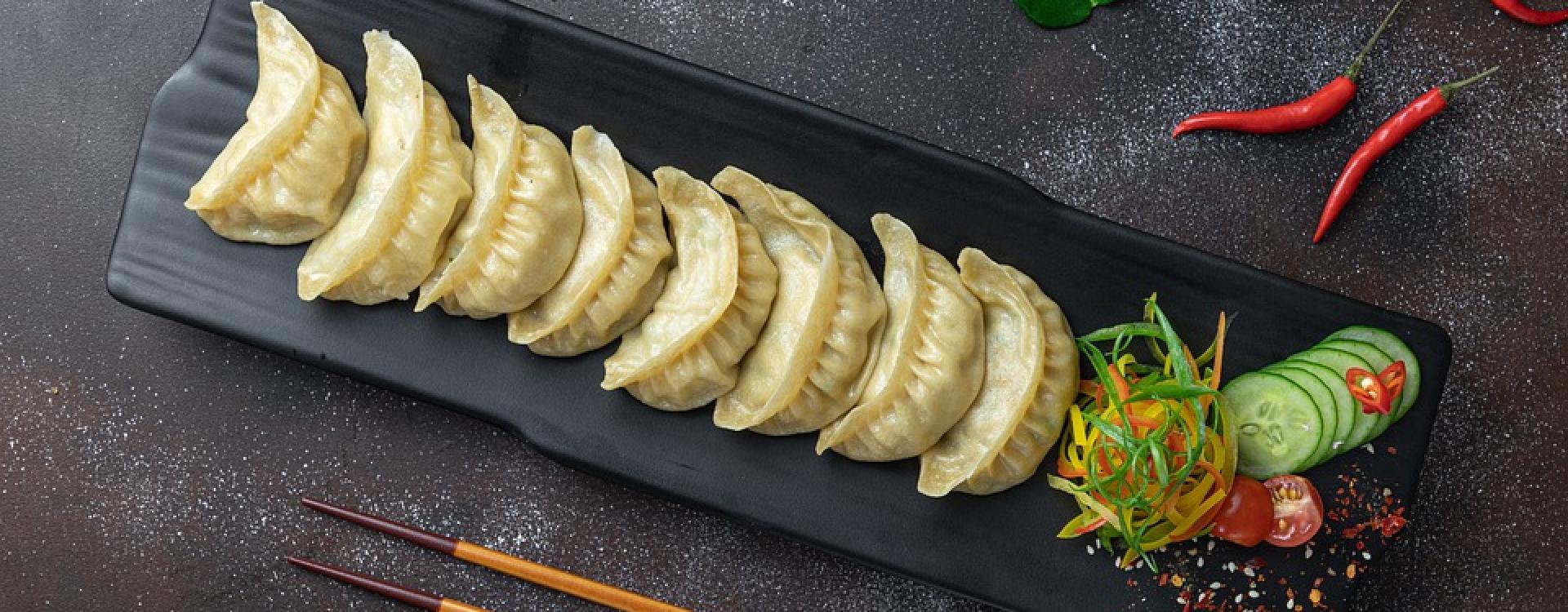
Nepalese cuisine is the most authentic, delicious, and popular cuisine around the globe. The cuisine of Nepal is rich in spices, herbs, and vegetables. The most common staples in Nepali cuisine include dal,bhat, tarkari,chow-mein, momos, roti, and aalu achar are also widely enjoyed.
Nepali desserts are known for their sweet taste and unique flavors. Some of the most popular Nepali desserts include laddoo, gulab jamun, halwa, kheer, and jalebi. A Popular Nepali street food is the chaat. Chaat is a savory snack made with potatoes, chickpeas, onions, and spices. Other street foods in Nepal include aalu tikki, Panipuri , and sekuwa .
Nepali foods include various beverages, such as tea, coffee, arak, lassi, and masala Chiya. These drinks are often enjoyed during meals or as a refreshing snack.
If you’re planning to go trekking in Nepal, including Everest Base Camp, Annapurna Base Camp, Annapurna Circuit, Langtang Valley, Manaslu Circuit Trek, Upper Mustang Trek, and Ghorepani Poon Hill, you should try this food on the trail.
Dal - Lentils
Chow Mein - Noodles
Tarkari - Curried vegetables
Roti - Flatbread
Momos - Dumplings filled with vegetables or meat
Thukpa - A Noodle Soup
Sel roti - A deep-fried sweet bread
Gunda - A meat and vegetable stew cooked with yogurt and spices
Aalu achar - Potato pickle
Aalu tikki - Potato fritters
Panipuri - Deep-fried pastries filled with potatoes and spices
Sekuwa - Barbecue
Lassi - Yogurt-based drinks
Masala Chiya - Spiced tea
Dal Bhat Tarkari is one of Nepal's traditional and popular cuisines, made with lentils and rice. It is a simple, flavorful Dal Bhat, and Tarkari has deep roots in the cultural heritage of Nepal. Dal, the main component of Dal Bhat, refers to lentils cooked to a creamy consistency. It is typically cooked fluffy and served alongside the dal and tarkari. Rice acts as a source of carbohydrates, complementing the protein-rich dal. Tarkari, or vegetable curry, adds vibrant flavors and textures to the meal. It consists of a variety of seasonal vegetables cooked with aromatic spices and herbs. Tarkari provides essential vitamins, minerals, and dietary fiber, enhancing the overall nutritional profile of the meal.
The traditional preparation of Dal Bhat and Tarkari involves slow cooking the dal with aromatic spices and tempering it with ghee or clarified butter. The rice is cooked separately by boiling or steaming. Tarkari is made by sautéing vegetables in oil and adding a spice blend known as masala.
The combination of protein-rich dal, carbohydrates from rice, and the fiber and micronutrients in tarkari create a balanced meal that promotes satiety and sustained energy levels. This balanced nutrition makes Dal Bhat and Tarkari popular for individuals leading an active lifestyle. Lentil Variations and Complementary Tarkari Various lentil variations are used in Dal Bhat, such as masoor dal, toor dal, and chana dal, each offering a distinct flavor and texture. Similarly, the choice of vegetables in the tarkari can be tailored to personal preferences and seasonal availability.
Dal Bhat and Tarkari hold immense cultural significance in Nepal. They are prominently featured in festivals, family gatherings, and celebratory occasions. Sharing a Dal Bhat and Tarkari meal symbolizes unity, love, and the spirit of hospitality.
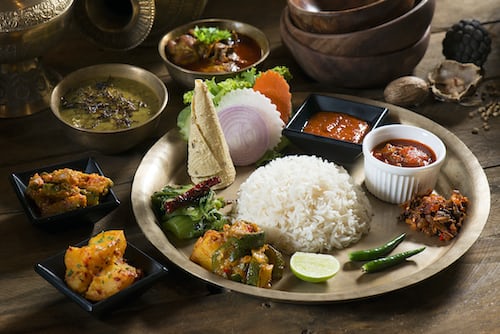
Dal Bhat Tarkari
Newari Khaja Set is a traditional culinary delight hailing from the Newari community of Nepal. Renowned for its rich flavors, unique dishes, and cultural significance, the Khaja Set offers a glimpse into the vibrant heritage of the Newari people. In this article, we will explore the components of a Khaja Set, traditional preparation methods, cultural significance, and more.
A typical Newari Khaja Set consists of several delectable dishes that come together to create a pleasant gastronomic experience. Let's explore some of the essential components:
The Newari Khaja Set holds significant cultural value in Nepalese society. It is integral to various festivals, celebrations, and social gatherings. During festivals like Dashain, Tihar, and New Year, families come together to share a Khaja Set, symbolizing unity, abundance, and joy. The Khaja Set becomes a centerpiece of celebrations, representing the Newari community's cultural heritage and communal bonds.
Kathmandu and Bhaktapur are renowned for their well-preserved Newari culture and culinary heritage. The narrow lanes of Kathmandu and Bhaktapur are home to traditional Newari restaurants where one can indulge in an authentic Khaja Set experience amidst the city's rich historical ambiance.
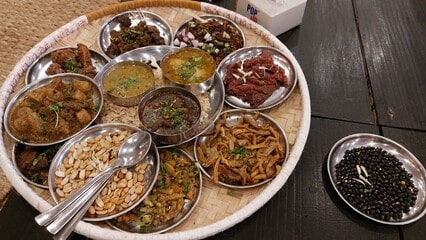
Newari Khaja Set
Momos, a delectable dumpling originating from Tibet, has gained immense popularity worldwide. These bite-sized parcels of joy are loved for their soft dough and flavorful fillings. Now, we will explore the origin, varieties, ingredients, cultural significance, health benefits, and tips for making perfect momos at home.
Momos have gained widespread popularity, particularly as street food. They are readily available in bustling markets, food stalls, and restaurants, enticing food lovers with their aromatic flavors and delightful presentation. Momos have also become an integral part of festivals and celebrations in various cultures. Momos have become a beloved street food item, enjoyed by people from all walks of life. The enticing aroma and the sight of momos being steamed or fried on the streets draw in locals and tourists alike, creating a vibrant street food culture.
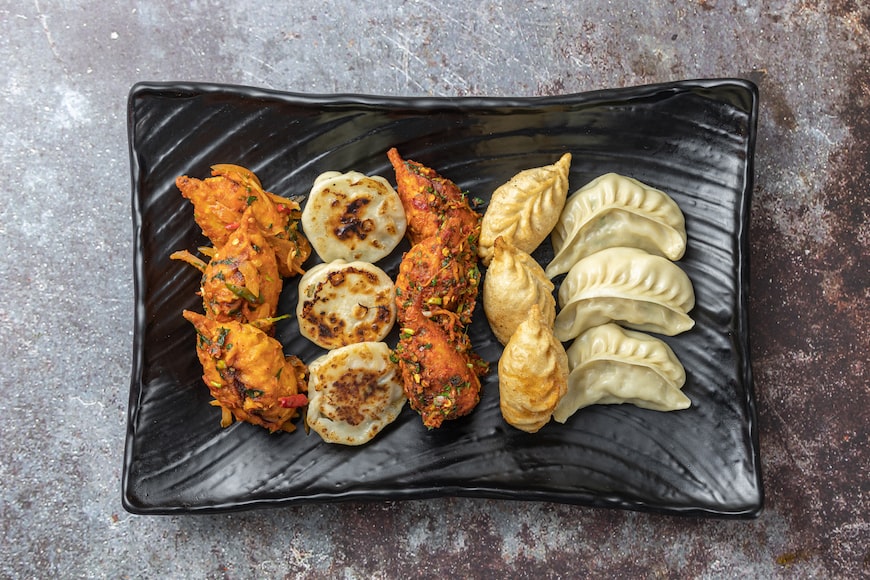
momos
Sel Roti, a traditional Nepali sweet, holds a special place in Nepalese cuisine and culture. This round-shaped, deep-fried delicacy is made from rice flour and is often enjoyed during festive occasions and celebrations and as a popular tea-time snack. Now, we will delve into the origin, ingredients, preparation, cultural significance, and various ways of enjoying this beloved treat.
Sel Roti has its origins in the Newar community of Nepal, particularly in the Kathmandu Valley. It is an integral part of Newari cuisine and is deeply rooted in Nepalese culture.
Sel Roti holds immense significance during festivals and special occasions in Nepal. It is commonly prepared during significant celebrations like Dashain, Tihar, and weddings. During these festive times, families come together to make and share Sel Roti as a symbol of joy, abundance, and communal harmony.
Sel Roti pairs wonderfully with a cup of tea or coffee. Its mildly sweet taste and crispy texture make it a perfect snack for leisurely tea breaks, providing a satisfying and indulgent treat. During festivals, Sel Roti takes center stage as a special treat. It is often served as a dessert alongside other traditional dishes, symbolizing joy, togetherness, and the spirit of celebration.
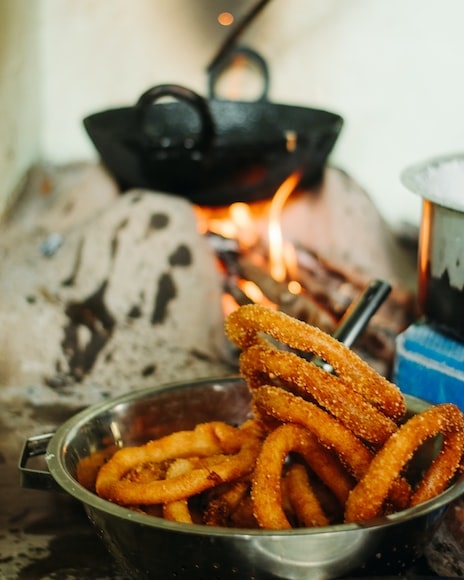
Sel Roti
Thakali Khana is a traditional Nepali meal that originates from the Thakali community, known for its unique cuisine and warm hospitality. This delightful spread features a combination of staple grains, flavorful meat and vegetable dishes, and aromatic spices. In this article, we will explore the origin, ingredients, cultural significance, traditional menu, and health benefits of Thakali Khana.
Thakali Khana has its roots in the Mustang region of Nepal, which is home to the Thakali people. The Thakali community has long been renowned for its culinary expertise, and Thakali Khana represents a culinary tradition passed down through generations. It is a delicious meal as well as a symbol of Thakali culture, community, and warm hospitality.
The popularity of Thakali Khana has expanded beyond traditional households, with many restaurants in Nepal and around the world featuring this authentic cuisine. Thakali restaurants often offer a complete Thakali Khana experience, serving a full range of dishes, including the traditional menu items mentioned earlier. These establishments strive to preserve the true essence of Thakali cuisine while catering to the diverse tastes of diners.
Thakali Khana is usually served with a side of pickles, chutney, and relish. Many Nepalese people are fond of Thakali Khana, and it can be easily found throughout the nation. It is a great way to experience the unique flavors of Nepalese cuisine. You can taste Thakali Cuisine when visiting Upper Mustang.
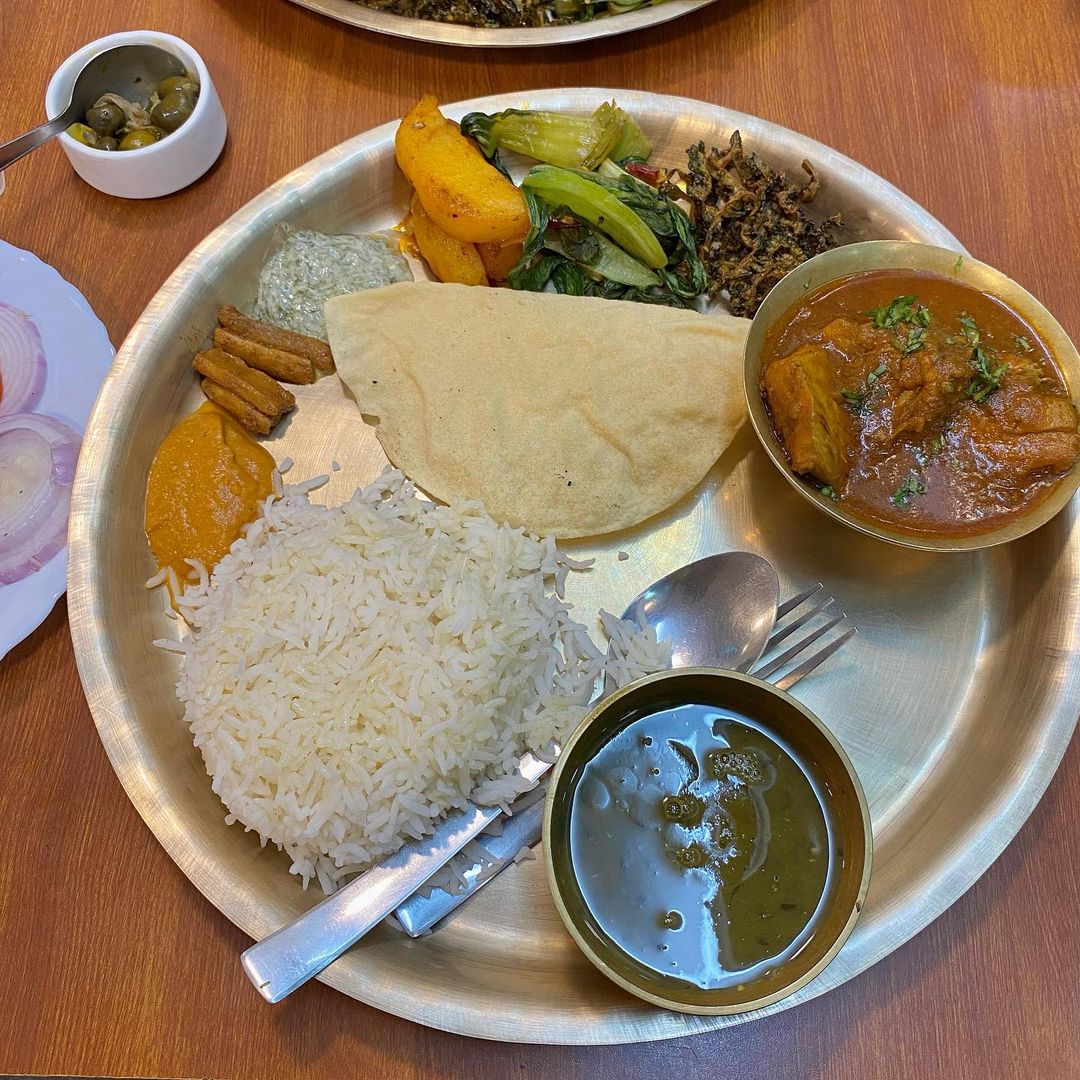
Thakali Khana
Chow Mein
With its delightful blend of stir-fried noodles, vegetables, and protein, Chow Mein has become a beloved dish worldwide. From its origins in China to the diverse regional variations and popular styles, Chow Mein showcases the culinary diversity and cultural significance of Chinese cuisine. Whether enjoyed as a main course or savored as street food, Chow Mein offers a satisfying and flavorful experience that continues to captivate food enthusiasts around the globe.
Chow Mein is also popular as a street food, where vendors whip up quick and delicious servings in bustling food stalls. Eating Chow Mein as a street food provides a unique experience, immersing you in the local culinary scene.
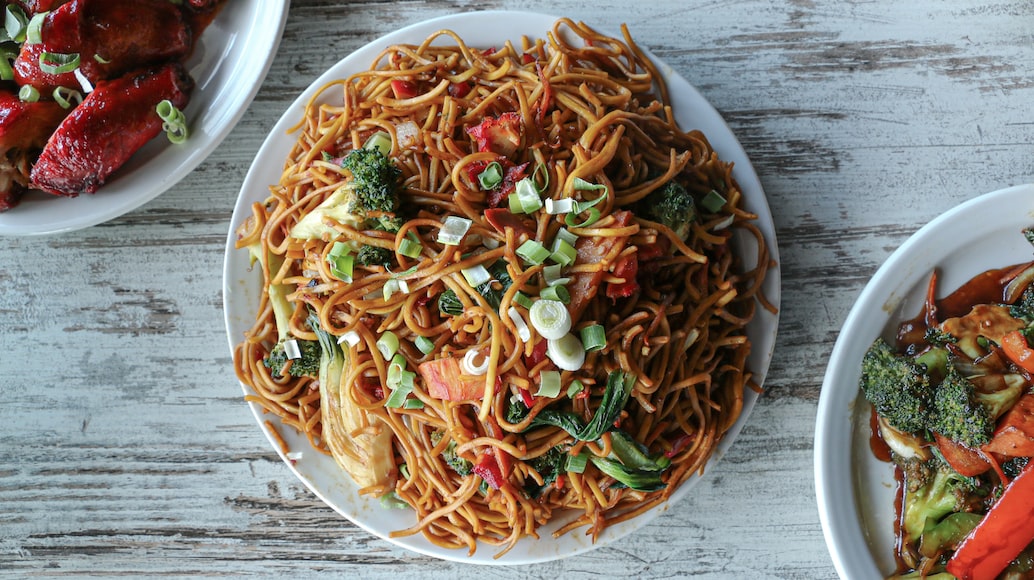
Chow Mein
Kwati is a traditional Nepalese cuisine that is enjoyed especially during the festival of Janāi Purnimā. It is made with nine different types of sprouted beans and is a popular delicacy in the country.
Kwati is unique in Nepali culture and deeply rooted in the country's traditions and festivals. It is believed that Kwati originated in the Kathmandu Valley and has been prepared for centuries during auspicious occasions like the festival of Gunla and the Nepali New Year. The dish is often served as a symbol of prosperity and good fortune, and its preparation involves a meticulous process that requires patience and skill.
While the traditional recipe of Kwati remains cherished, modern variations have emerged over time, offering a unique twist to this classic dish. Some variations include adding vegetables like carrots and potatoes, incorporating meat such as lamb or chicken, or even experimenting with different spice blends to cater to individual preferences. These variations have helped Kwati gain popularity within Nepal and among food enthusiasts worldwide.
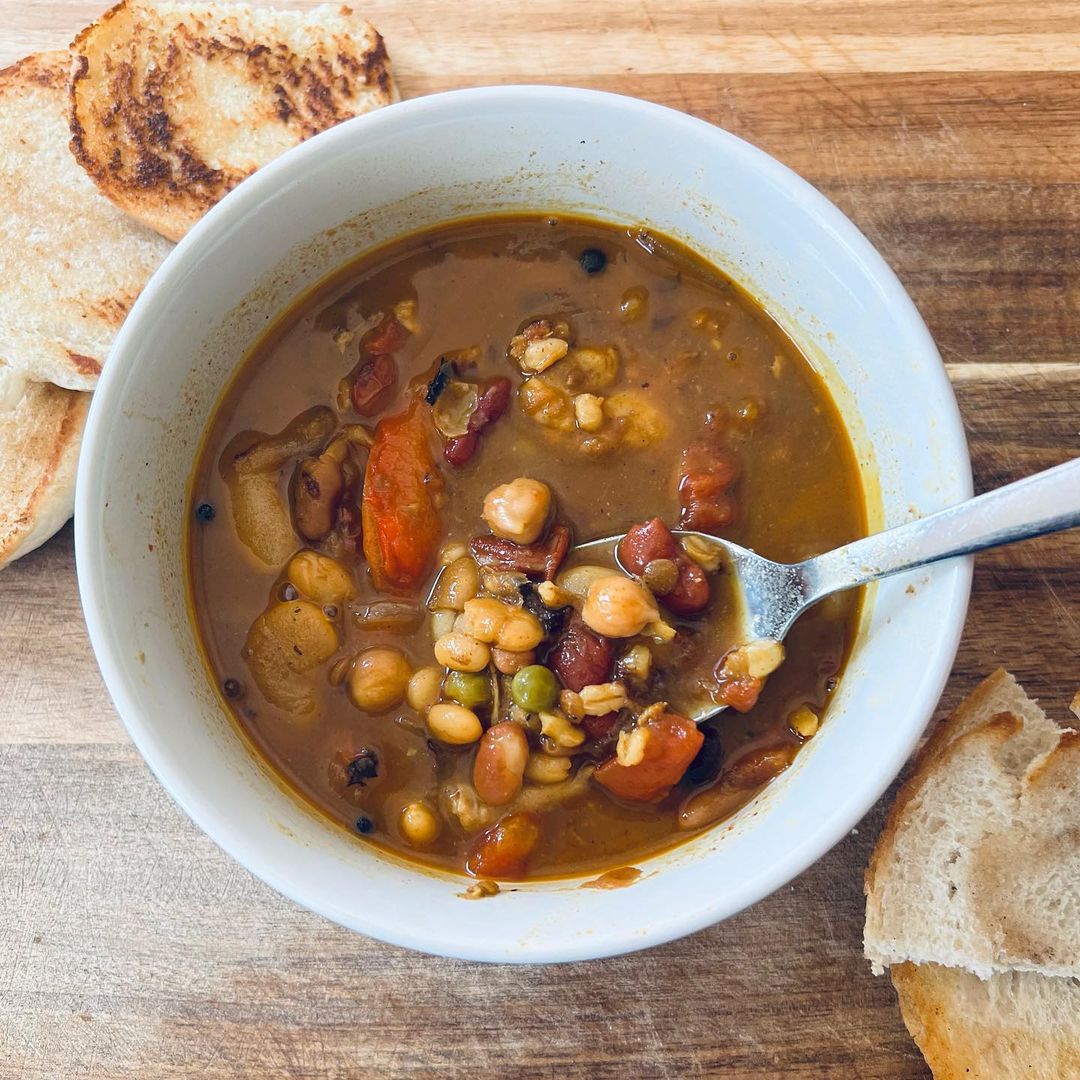
Kwati
Pulau, also known as Pilaf, is a beloved Nepali dish showcasing the country's diverse culinary heritage. It is a rice-based dish cooked with a medley of spices, vegetables, and often meat, resulting in a flavorful and aromatic creation. Pulau holds a special place in Nepali households and is commonly prepared for festive occasions, celebrations, and family gatherings.
As with many traditional dishes, Pulau has regional variations across Nepal. In the Kathmandu Valley, for example, Pulau is often prepared with a mix of basmati rice, aromatic spices, and vegetables. In the Newari community, a traditional version called "Samay Baji" includes Pulau as one of the dishes served during festivals. In the Terai region, Pulau may be cooked with a different combination of spices and local ingredients, reflecting the diverse culinary traditions within the country.
In Nepali culture, Pulau is synonymous with celebrations and special occasions. Whether it's weddings, festivals like Dashain and Tihar, or family gatherings, Pulau often takes center stage as a dish that brings people together. Its aromatic aroma and rich flavors create a festive atmosphere, symbolizing abundance, joy, and unity.
As Nepali cuisine gains recognition globally, Pulau has also found its way onto international menus. Nepali restaurants in different parts of the world serve Pulau, allowing people to experience the flavors of Nepal outside its borders. Its versatility as a vegetarian or meat-based dish makes it appealing to a wide range of palates, ensuring that Pulau continues to charm food enthusiasts worldwide.
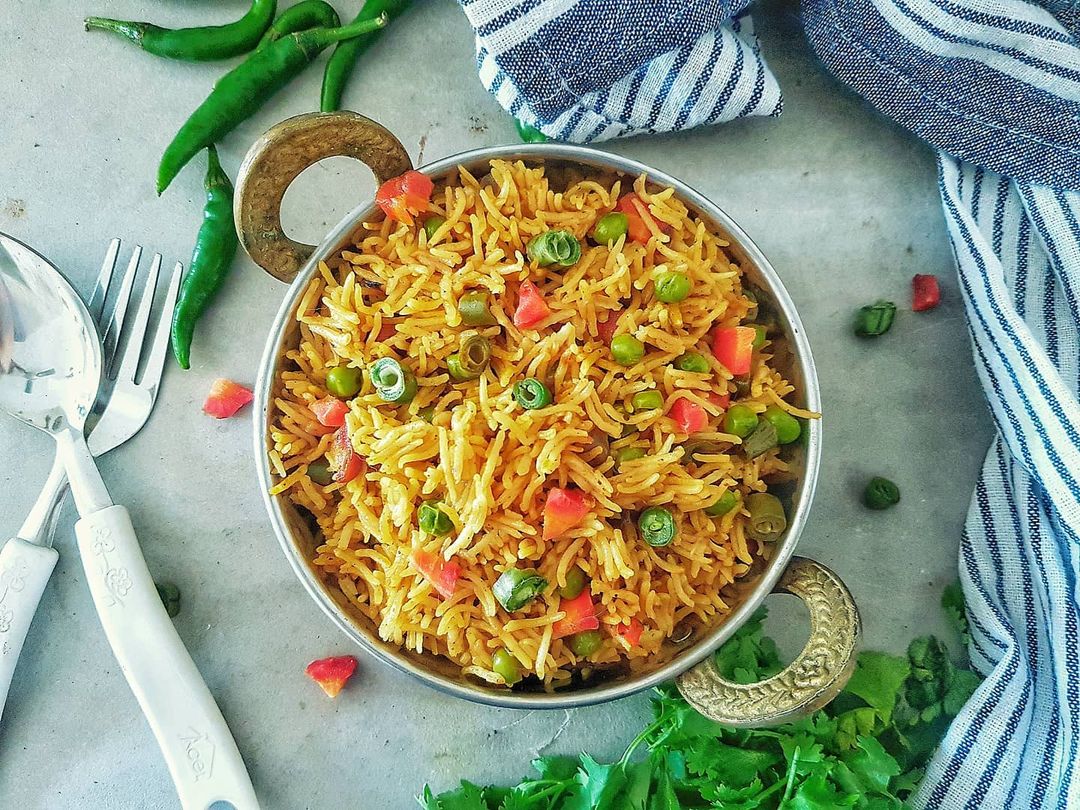
Pulau
Samosa is a popular snack in Nepal that can be found in nearly every corner of the country. It is a deep-fried pastry filled with a savory filling, usually consisting of spiced potatoes and other vegetables. The dough is made of flour, salt, and water, and the filling is often seasoned with garam masala, cumin, chili powder, and other spices. Samosas are generally served with chutney or sauces.
Samosa offers a canvas for culinary creativity, leading to various regional and cultural variations across Nepal. In addition to the classic vegetarian Samosa, you can find meat-filled Samosas, such as chicken or mutton, adding a savory twist to this beloved snack. Some regions may also incorporate unique ingredients and spices, showcasing the diversity of Nepali cuisine.
One cannot mention Samosa without highlighting its status as a popular street food in Nepal. From bustling marketplaces to roadside stalls, Samosas are a common sight, enticing passersby with their aromatic fragrance and crispy allure. Whether enjoyed as a quick snack or a satisfying meal, Samosas have become an essential part of street food culture in Nepal.
While Samosas are undoubtedly a delightful indulgence, they also offer some nutritional benefits. The filling, typically consisting of vegetables or meat, provides essential nutrients like vitamins, minerals, and proteins. However, moderation is vital, as the deep-frying process adds extra calories. Pairing Samosas with fresh salads or chutneys can add a nutritious element to the meal.
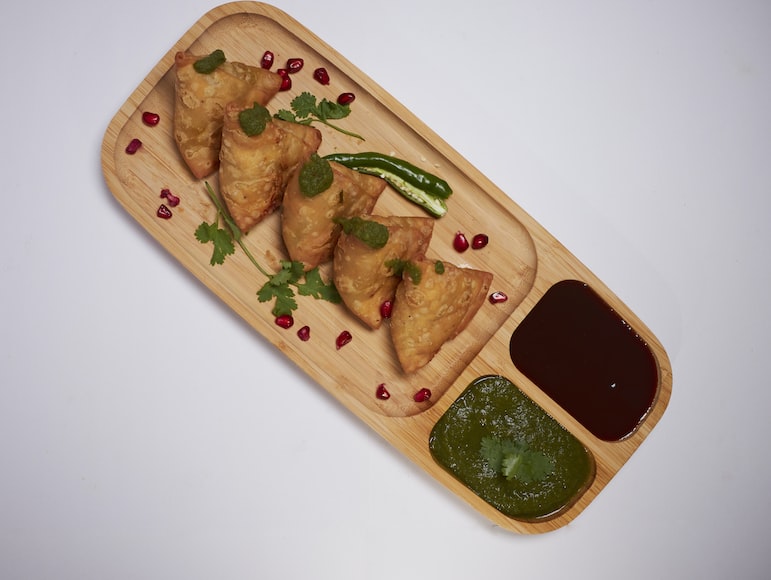
Samosa
Juju Dhau, which means ‘King of Yogurt’ in Nepali, is a traditional Nepalese dessert made with thickened yogurt. It is one of the most popular snacks in Nepal and is enjoyed as a dessert or snack. This creamy, sweet yogurt dish is often served with other foods, such as fruits, nuts, and sweetened condensed milk, to create an even more flavorful experience.
To savor the authentic taste of Juju Dhau, one must visit the Bhaktapur district of Nepal, where it originated. Numerous local dairy farms and small-scale producers offer this delightful yogurt. Juju Dhau is also available in select Nepali restaurants and sweet shops across the country.
The base of Juju Dhau is made with freshly curdled cow or water buffalo milk that is then boiled and cooled. The cooled milk is mixed with a paste made from mung beans and spices. This mixture is then strained to create a thick, creamy yogurt.
Juju Dhau stands as a testament to the rich culinary heritage of Nepal. Its creamy texture, distinct flavor, and cultural significance make it a cherished delicacy among Nepali people. From auspicious celebrations to everyday indulgences, Juju Dhau represents the sweetness of life and the joy of coming together. So, when in Nepal, don't miss the opportunity to savor this exquisite treat and immerse yourself in the flavors of the land.
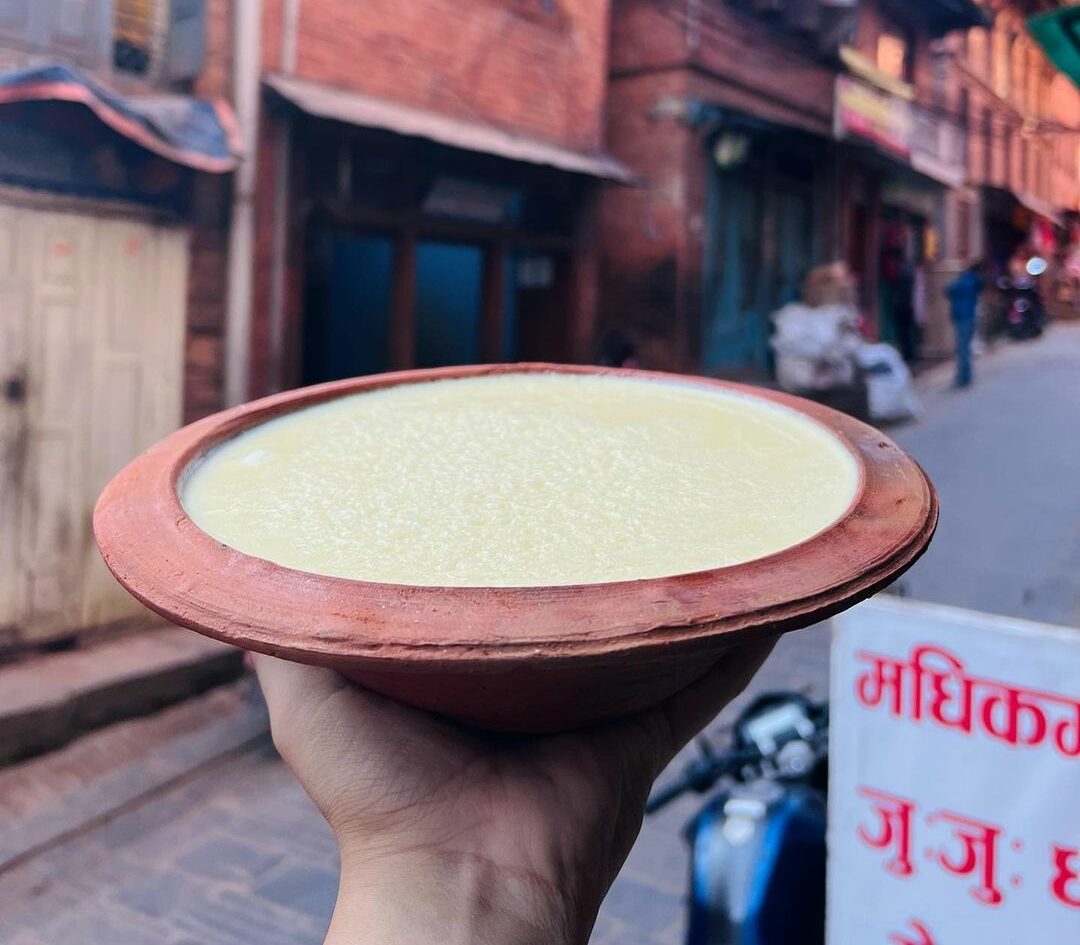
Juju Dhau